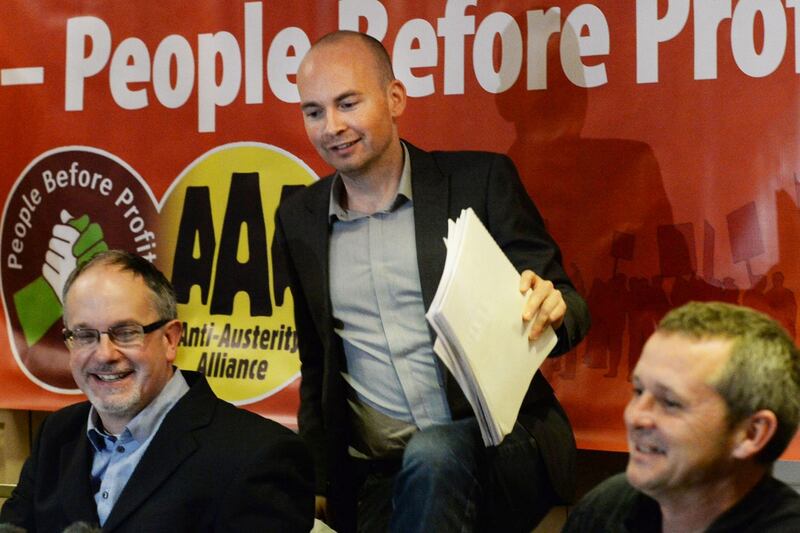Martin McGuinness’s retirement, while not unexpected given his serious medical condition, creates an enormous lacuna in the heart of Sinn Féin’s leadership.
In due course, McGuinness’s departure will also emphasise something important: the basic difference between the requirements of politics in the North and the South.
Sinn Féin talks a lot about its "collective leadership" model, and it is true that the sometimes hostile outsider view of the party as being basically a twin dictatorship run by McGuinness and Gerry Adams misses the extent to which the two men listen to those around them, be they the men and women of the martial generation or the younger generation (which, like the rest of us, is not as young as it used to be).
But there is no doubt that the decisive voices are those of the Adams-McGuinness axis. Now one part of that extraordinary partnership leaves the stage.
It is noticeable that after a decade of participation in the power-sharing administration in the North, there is no clear or obvious successor to McGuinness as leader of the party in Stormont. None of the next generation has distinguished themselves as such outstandingly capable ministers that they are the natural choice to take over.
Health minister Michelle O’Neill was put forward last week as the leader of the party’s Stormont delegation in McGuinness’s absence and is expected to be named on Monday as the party’s leader in the forthcoming elections.
Expectations
Previously, most of the expectations had centred on Newry-Armagh MLA
Conor Murphy
. Finance minister Máirtín Ó Muilleoir was also mentioned. One Sinn Féin elected representative repeatedly mentioned
Chris Hazzard
. To say that none of these is exactly a household name in the South is an understatement. Indeed, they may not even be household names in the North.
The selection of the new leader is made by the party’s chiefs rather than a vote of the MLAs or the membership. That is still how the important decisions are made.
It is clear from their determination to have an election that Sinn Féin believes it to be in the party’s interests. It believes the DUP is on the run, if you’ll pardon the phrase.
And there is a small chance that Sinn Féin could emerge the largest party in the assembly after the elections; a development which would almost certainly result in fresh elections (following the failure to form a government) where unionist primacy was restored, as unionist voters returned to the DUP to avert the prospect of a Shinner as First Minister.
More likely the new assembly will return not enormously different to what it is there now. There will then be a three-week period to agree a new executive. That is when Sinn Féin will feel the absence of McGuinness’s stature, his political skills and his ability to reach out with authority and humility to unionists. The breakdown in Northern politics will then resume, requiring the two Governments to become involved. That process could drag on for some time; a quick resumption of power-sharing at Stormont is most unlikely.
That might also allow everyone, including Sinn Féin, to rethink what the Northern Executive is actually for. So far, the definition of success has been not collapsing. If there is an emerging theme to the election in the North, it is a sense that more is required from its politics, and from its political class. Whether that survives the inevitable sectarian dog whistles is an open question.
Grimace
A hiatus would not be the worst things for Sinn Féin. Government in the North has the complication of making opposition in the South more difficult. Sinn Féin TDs grimace and shake their heads furiously when Fianna Fáil, Fine Gael and Labour TDs tease them about implementing austerity in the North while opposed to it in the South, but there is more than a grain of truth to it – because, as political grown-ups, the party realises that government usually involves choosing between several uncomfortable alternatives.
There are other challenges in the South too. There is the succession from Adams to Mary Lou McDonald, for one thing. McGuinness told people that he had planned to retire in May, as part of the party’s transition to the new generation. Adams has certainly contemplated the same question, though McGuinness’s retirement has probably postponed his departure. But the longer he waits, the less of an impact McDonald’s ascension to the leadership is likely to have.
And there is the question of the party’s political strategy to deal with the changed circumstances in the South.
The strategy adopted in 2015 was to rule out supporting a Fianna Fáil or Fine Gael-led coalition and seek to lead the next Government – the “left-first”, two-elections plan. When it was making that decision – rubber-stamped at a rollicking ard fheis presided over by Martin McGuinness in his hometown two years ago – the party anticipated that it would by now be leading a left-wing opposition in the Dáil, readying to take power after the next election. But the party was wrong-footed by the construction of the current government.
Sinn Féin is becoming a left-wing, working-class party, with strong youth support, though the latter is fickle and unreliable.
It has two routes to Government: one as the leader of a broad left coalition, the other as part of a coalition dominated by one of the big two centrist parties. Neither looks remotely likely at present.













